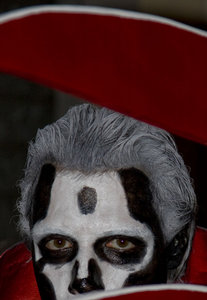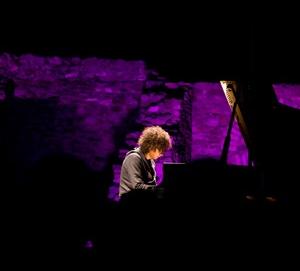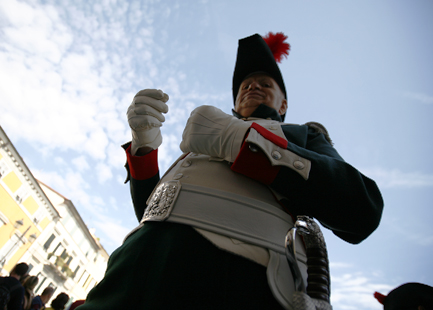Ciao a tutti.
Questa volta posto una specie di “recensione” sull’evento che ogni anno (da 6) si ripete a Lucca.
E’ un festival grazie al quale sono allestite varie mostre foto e video sparse per tutta la città di Lucca: fin qui niente di male, anzi!
E’ davvero bello passeggiare per Lucca e scoprire in chiese, chiostri ed ex-fabbriche, fotografie da tutto il mondo, specialmente quelle del World Press Photo (WPP).
Però qualcuno mi dovrebbe spiegare quale sia il razionale che ha spinto gli organizzatori a presentare del materiale così “particolare”.
Non riesco a capire cosa c’entri con la fotografia un lavoro come quello di Sandy Skoglund (sito): lavoro probabilmente di altissima caratura artistica, dove però la fotografia è solo un supporto per rappresentare installazioni visionarie che sinceramente ho avuto qualche difficoltà a comprendere.
E che dire della mostra di Jan Suadek (sito)? Una sequenza di nudi oscillanti fra il cattivo gusto e l’onirica volgarità, il tutto presentato in uno stanzone ormai disadorno delle ex-manifatture tabacchi, sotto un’impietosa luce gialloverde.
Probabilmente il mio gusto fotografico è troppo lontano da tali esempi.
Non perdo tempo a commentarvi le mostre di Francesca Woodman, Paola Binante (“Paralipomeni” (qua), mostra fiacca nascosta da un parolone che viene usato, come già in ambito biblico, per indicare un’aggiunta di cose precedentemente tralasciate, dal greco paraleipómena, a sua volta da paralèipô, appunto omettere, tralasciare), Missirkov/Bogdanov (“Cvetana Maneva” (qua)): anche qua nessuna scintilla è scoccata, e me ne sono andato via deluso ogni volta.
Più sulle mie corde il reportage sui Rom di Sara Munari: tema difficilissimo, svolto a mio parere in punta di piedi, lasciandosi alle spalle i soliti pregiudizi.
Andando avanti potremmo chiederci perchè sacrificare l’esposizione del WPP? La location era meravigliosa, la Chiesa dei Servi, con i marmi policromi delle pareti che si mescolavano con i colori delle foto, di numero tristemente scarno: una dei fiori all’occhiello del LDPF così sacrificato?
Fortuna che ho potuto ammirare le mostre di Giorgia Florio (sito) e Donna Ferrato (sito): ottimi esempi di fotogiornalismo o almeno di storie raccontate tramite le foto, dove si può apprezzare il messaggio e la visione che il fotografo ci ha voluto donare.
Un’altra iniziativa che mi è piaciuta molto è stata la serie di lectures organizzate in modo che i fotografi potessero descrivere se stessi, il proprio lavoro e le proprie aspirazioni: davvero carismatica è stata quella di Giulia Florio, interessante quella con i vincitori italiani al WPP 2010 (peccato che quasi tutti non fossero presenti, a parte Ausili, il cui racconto sui mattatoi colpisce davvero allo stomaco).
Notevole la mostra di Michel Comte (“Not Only Women”) al L.u.C.C.A. (Lucca Center of Contemporary Art): le donne da lui fotografate non sono mai oggetti, sono sempre soggetti che, con la sua arte, il fotografo riesce a trasformare in icone della femminilità contemporanea (dalla presentazione della mostra), riassumendo una gran parata di gnocche!
Direi un bilancio in chiaro/scuro: purtroppo ho l’impressione che man mano che gli anni passano la qualità generale delle opere esposte vada a calare, o almeno ad allontanarsi dal mio gusto.
Un piccolo slide show di quanto ho visto delle mostre di LPDF (con musica dei Depeche Mode!) … basta un click sull’immagine sotto.
Hello folks.
This post is a review about Lucca Digital Photo Festival 2010, an event that takes place in Lucca every year (since 2005).
All exhibitions are hosted in many places in the city of Lucca.
It’s really nice to walk in to discover Lucca and churches, cloisters and former factories, places full of photographs from around the world, especially those of the World Press Photo (WPP).
But someone should tell us what’s the rationale that has driven the organizers.
I cannot understand what has to do with photography the exhibition of Sandy Skoglund (site): maybe she’s an artist, but photography is only a visionary support for her installations.
And what about the exhibition of Jan Suadek’s work (site)? A sequence of naked varying between bad taste and vulgarity dream, all presented in an empty, big room of the former tobacco factory of Lucca (aka Manifattura Tabacchi Lucca), in a pitiless light yellow-green.
Probably my photographic mood is too far from these examples.
I don’t waste time to comment on the exhibition of Francesca Woodman, Paola Binante (“Paralipomeni” (here), a weak show hidden by a big word that is used, as in the biblical context, to indicate the addition of things previously left out, from the greek paraleipómena in turn by paralèipô, just omit, leave out), Missirkov / Bogdanov (“Cvetan Maneva”).
Going forward we might ask why WPP exhibition was so sacrificed? The location was wonderful, the Church of the Servants, with multi-colored marble walls that blend with the colors of the photos: but why lacking in quantity?
I was really lucky to admire the exhibits Giorgia Florio (site) and Donna Ferrato (site), excellent examples of photojournalism, of stories told through photos, where you can appreciate the message and vision that the photographers wanted us to donate.
Another initiative that I really liked was the series of lectures organized so that photographers could describe themselves, their work and their aspirations: the best one was Giulia Florio, another interesting one was the italian winners of the WPP 2010 (pity that almost all were not present, apart from Ausili, whose story about slaughterhouses really hits the stomach).
The remarkable exhibition of Michel Comte (“Not Only Women”) at Lu.c.c.a. (Lucca Center of Contemporary Art): this exhibition arises from an assumption that all too often the fashion portrait, in particular the female one, only has to be studied from iconographic and stylistic points of view. Michel Comte overturns this assumption.
A small slide show of what I have seen exhibitions of LPDF (with music by Depeche Mode) … just click the image above.







